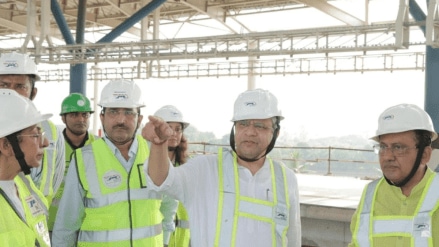Railway minister Ashwini Vaishnaw on Saturday announced the government’s plans to open the first stretch of the country’s inaugural bullet train project between Surat and Bilimora in Gujarat by 2027. The Mumbai-Ahmedabad bullet train is India’s first high-speed rail line, which utilises Japanese Shinkansen technology. The project is a joint venture between the Indian administration and the state governments of Gujarat and Maharashtra.
What did Vaishnaw say?
Vaishnaw announced the big plans for the train during his official visit to the construction site at the Surat station in Gujarat, where the tracks for the high-speed line are being installed. Speaking to reporters after his visit, Vaishnaw said the bullet train will be able to cover the distance between Mumbai and Ahmedabad in two hours. “So practically from Surat you can go to Mumbai in 1 hour, complete your work & come back and have time with your family. Same thing from Ahmedabad, you can go to Mumbai in 2 hours, complete your work and then spend time with your family,” Vaishnaw said.
The minister highlighted the use of modern technology to ensure safety, including vibration absorption mechanisms along the track and special safety features to handle high winds and earthquakes.
So practically from Surat you can go to Mumbai in 1 hour, complete your work & come back and have time with your family. Same thing from Ahmedabad, you can go to Mumbai in 2 hours, complete your work and then spend time with your family: Hon’ble MR @AshwiniVaishnaw#BulletTrain pic.twitter.com/guZ2FByGWC
— Ministry of Railways (@RailMinIndia) September 27, 2025
India’s first bullet train: Speed and key features
The main line of operation for the vehicle is designed for speeds up to 320 kilometres per hour. The services are designed such that a train will depart every half an hour during the morning and evening peak hours. “Once the entire network stabilises, there will be a train every 10 minutes during peak hours,” Vaishnaw said.
The estimated cost of the project is approximately Rs 1.08 lakh crore. About 81% of the total cost is being funded by a soft loan from the Japan International Cooperation Agency (JICA). Whereas the remaining cost is split between the Indian government’s Ministry of Railways (50%) and the state governments of Maharashtra (25%) and Gujarat (25%).
The entire Mumbai-Ahmedabad corridor is set to be fully operational by 2029. The project will also witness India’s first 7-kilometre undersea rail tunnel, which is presently being built under the Thane Creek as part of a 21-kilometre tunnel in Maharashtra. The project is expected to integrate the economies of major cities along the corridor and spur regional growth, similar to Japan’s growth story after its high-speed rail.
